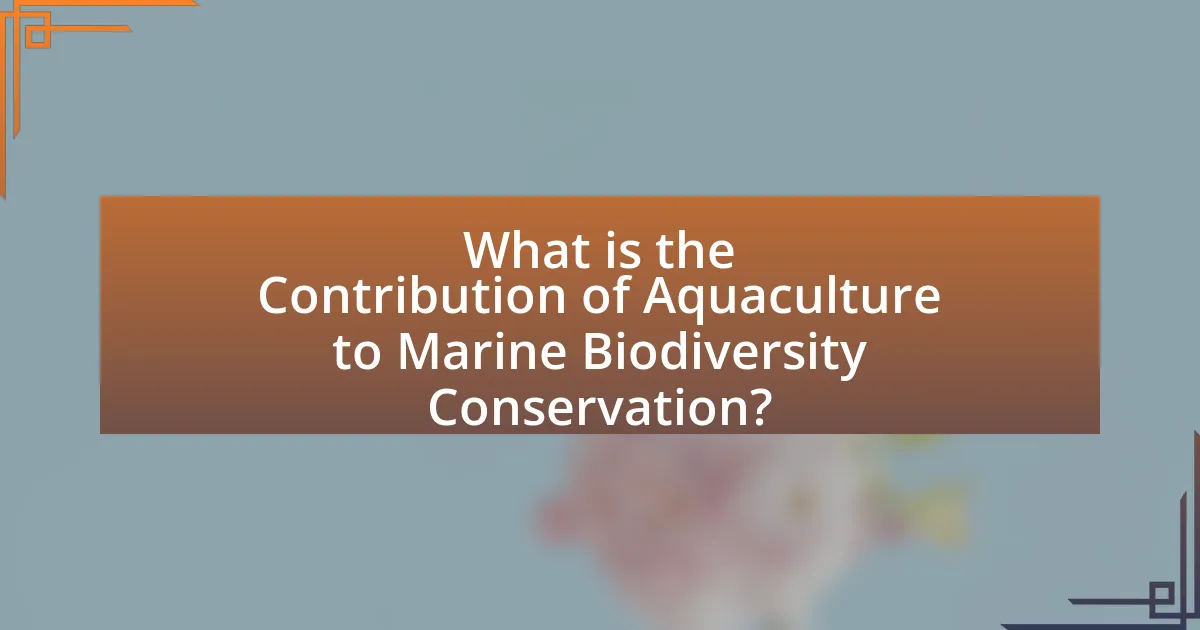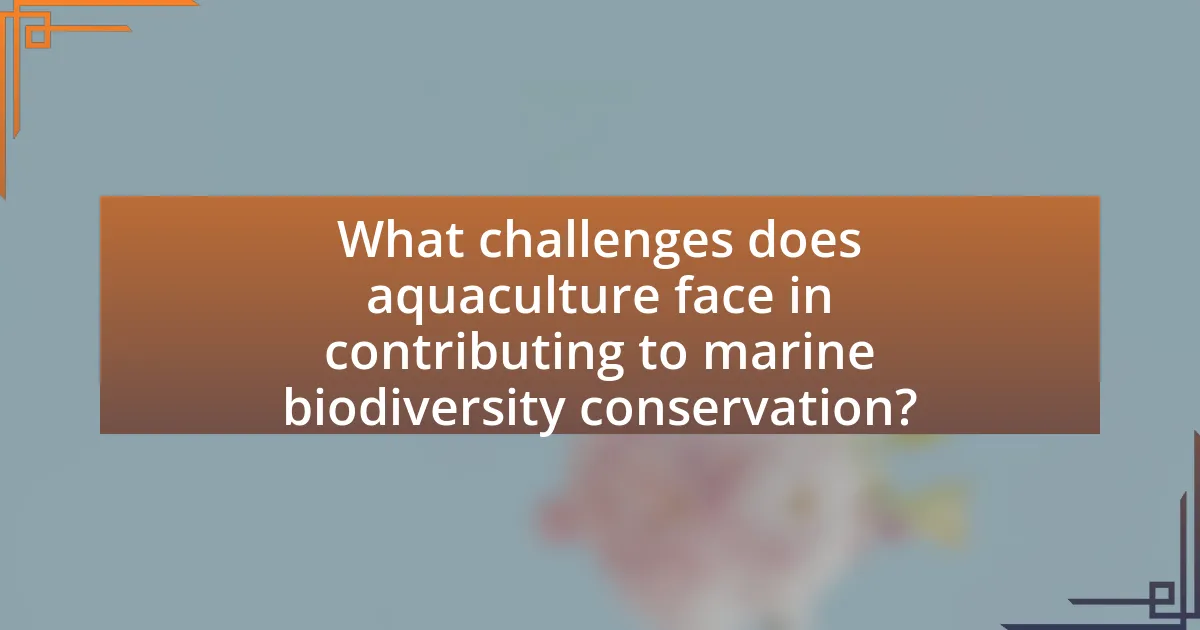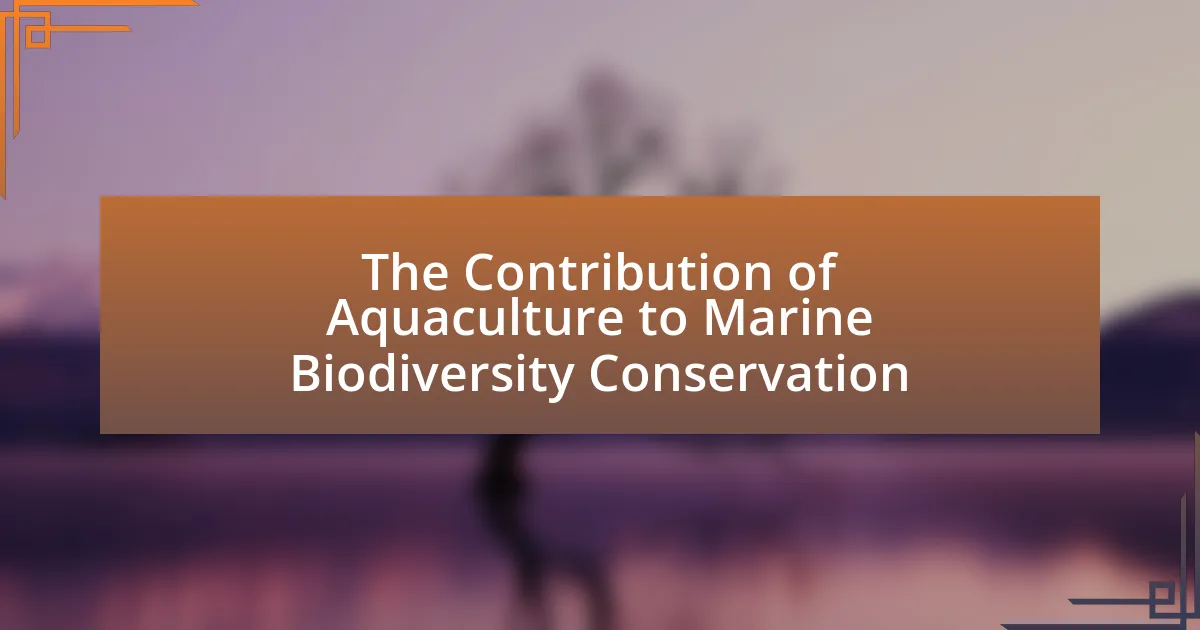Aquaculture plays a significant role in marine biodiversity conservation by providing sustainable alternatives to wild fishing, thereby alleviating pressure on overexploited marine species. The article explores how aquaculture contributes to habitat restoration, species conservation, and sustainable resource management, while also addressing its impacts on marine ecosystems, including potential competition with wild populations and nutrient loading. It highlights the benefits of aquaculture practices, such as integrated multi-trophic aquaculture, and discusses the challenges faced, including habitat degradation and pollution. Furthermore, the article emphasizes the importance of marine biodiversity for ecological balance and human communities, outlining best practices and collaborative approaches to enhance the synergy between aquaculture and conservation efforts.

What is the Contribution of Aquaculture to Marine Biodiversity Conservation?
Aquaculture contributes to marine biodiversity conservation by providing sustainable alternatives to wild fishing, thereby reducing pressure on overexploited marine species. By cultivating fish and shellfish in controlled environments, aquaculture helps maintain fish populations and supports ecosystem balance. For instance, the FAO reported that aquaculture production reached 114.5 million tons in 2018, which alleviates the demand for wild-caught fish, allowing marine ecosystems to recover. Additionally, aquaculture practices can include habitat restoration efforts, such as the cultivation of seaweeds and shellfish that enhance coastal ecosystems and improve water quality.
How does aquaculture impact marine ecosystems?
Aquaculture impacts marine ecosystems primarily by altering habitat structures and nutrient dynamics. The introduction of farmed species can lead to competition with wild populations, potentially disrupting local biodiversity. For instance, studies have shown that the escape of farmed fish can result in genetic dilution of wild stocks, affecting their resilience and adaptability. Additionally, aquaculture operations can contribute to nutrient loading in surrounding waters, which may cause eutrophication, leading to harmful algal blooms that deplete oxygen levels and harm marine life. Research indicates that in regions with intensive aquaculture, such as the Mediterranean, these effects can significantly alter community structures and ecosystem functions.
What are the key mechanisms through which aquaculture supports biodiversity?
Aquaculture supports biodiversity primarily through habitat restoration, species conservation, and sustainable resource management. Habitat restoration occurs when aquaculture practices, such as the cultivation of shellfish and seaweed, enhance coastal ecosystems, providing essential habitats for various marine species. Species conservation is facilitated by aquaculture’s role in breeding and reintroducing endangered species, thereby helping to maintain genetic diversity. Sustainable resource management is achieved through practices that reduce overfishing pressures on wild populations, allowing ecosystems to recover and thrive. These mechanisms collectively contribute to the preservation and enhancement of marine biodiversity.
How does aquaculture compare to traditional fishing in terms of biodiversity impact?
Aquaculture generally has a lower biodiversity impact compared to traditional fishing. Traditional fishing often leads to overfishing, habitat destruction, and bycatch, which significantly reduce marine biodiversity. For instance, studies indicate that over 30% of global fish stocks are overfished, leading to declines in species diversity. In contrast, aquaculture can be managed to minimize environmental impacts, such as through the use of sustainable practices and integrated multi-trophic aquaculture, which can enhance local biodiversity. Research published in “Aquaculture” by Troell et al. (2014) highlights that well-managed aquaculture systems can support ecosystem services and biodiversity conservation, demonstrating a more favorable impact on marine ecosystems compared to traditional fishing methods.
Why is marine biodiversity important for ecological balance?
Marine biodiversity is crucial for ecological balance because it enhances ecosystem resilience, productivity, and stability. Diverse marine species contribute to various ecological functions, such as nutrient cycling, habitat formation, and food web dynamics. For instance, coral reefs, which host a multitude of species, provide essential services like coastal protection and support fisheries that are vital for human livelihoods. Studies indicate that ecosystems with higher biodiversity are better equipped to withstand environmental changes and recover from disturbances, as seen in the resilience of diverse fish populations to overfishing pressures. Thus, maintaining marine biodiversity is essential for sustaining healthy ecosystems and the services they provide.
What roles do diverse marine species play in ecosystem health?
Diverse marine species play critical roles in maintaining ecosystem health by contributing to biodiversity, nutrient cycling, and habitat stability. Biodiversity enhances resilience against environmental changes and disturbances, ensuring that ecosystems can recover from stressors. For instance, various species fulfill different ecological functions, such as predation, herbivory, and decomposition, which collectively support food web dynamics. Additionally, species like corals and seagrasses provide essential habitats for numerous marine organisms, promoting overall ecosystem productivity. Research indicates that ecosystems with higher species diversity exhibit greater stability and productivity, as evidenced by studies showing that diverse coral reefs can better withstand bleaching events compared to monoculture reefs.
How does the loss of marine biodiversity affect human communities?
The loss of marine biodiversity negatively impacts human communities by disrupting food security, economic stability, and ecosystem services. Marine biodiversity is crucial for sustaining fish populations, which are a primary protein source for billions of people globally; for instance, approximately 3 billion people rely on fish as their main source of protein. Additionally, the decline in diverse marine species can lead to reduced resilience of marine ecosystems, affecting their ability to provide essential services such as coastal protection and carbon sequestration. Economic activities, particularly in coastal regions that depend on fishing and tourism, suffer as biodiversity declines, leading to job losses and decreased income. Studies indicate that regions with higher marine biodiversity tend to have more robust fisheries, underscoring the direct correlation between biodiversity and human livelihoods.

What are the specific benefits of aquaculture for marine biodiversity?
Aquaculture provides specific benefits for marine biodiversity by promoting species conservation, enhancing habitat restoration, and reducing overfishing pressures. By cultivating various marine species, aquaculture helps to maintain genetic diversity and supports the recovery of endangered species, such as certain fish and shellfish. Additionally, aquaculture systems can be designed to restore habitats, such as mangroves and seagrasses, which are crucial for marine ecosystems. Furthermore, by supplying seafood through aquaculture, the reliance on wild fish stocks decreases, alleviating the stress on overexploited marine populations. Studies indicate that sustainable aquaculture practices can lead to improved ecosystem health and resilience, thereby contributing positively to marine biodiversity conservation efforts.
How does aquaculture contribute to habitat restoration?
Aquaculture contributes to habitat restoration by creating artificial reefs and enhancing biodiversity in marine ecosystems. Through the cultivation of species such as oysters and mussels, aquaculture can improve water quality and provide essential habitat for various marine organisms. For instance, oyster reefs can filter large volumes of water, removing pollutants and promoting clearer waters, which benefits other aquatic life. Studies have shown that restored oyster reefs can support up to 300 species of fish and invertebrates, demonstrating the significant ecological impact of aquaculture practices on habitat restoration.
What types of habitats can aquaculture help restore?
Aquaculture can help restore coastal habitats such as mangroves, seagrasses, and salt marshes. These ecosystems are crucial for marine biodiversity, providing nursery grounds for fish and other marine organisms. For instance, the restoration of mangroves through aquaculture practices has been shown to enhance local fish populations and improve water quality, as evidenced by studies indicating that mangrove restoration can lead to a 50% increase in fish biomass in adjacent waters. Additionally, seagrass restoration efforts linked to aquaculture have demonstrated significant improvements in habitat complexity and biodiversity, supporting various marine species.
How effective is aquaculture in restoring degraded marine environments?
Aquaculture is effective in restoring degraded marine environments by enhancing biodiversity and improving ecosystem health. Studies indicate that aquaculture practices, such as the cultivation of shellfish and seaweeds, can help restore habitats, increase water quality, and provide essential ecosystem services. For instance, a study published in the journal “Marine Ecology Progress Series” found that shellfish aquaculture can significantly improve water clarity and nutrient cycling, which benefits surrounding marine life. Additionally, aquaculture can contribute to the rehabilitation of coastal areas by creating artificial reefs that support diverse marine species, thereby promoting biodiversity.
What role does aquaculture play in species conservation?
Aquaculture plays a significant role in species conservation by providing a sustainable alternative to wild capture fisheries, thereby reducing pressure on overexploited fish populations. By cultivating species in controlled environments, aquaculture can help replenish declining stocks and maintain genetic diversity. For instance, the breeding programs in aquaculture have successfully restored populations of endangered species such as the Atlantic salmon, which faced severe declines due to overfishing and habitat loss. Additionally, aquaculture can support conservation efforts by supplying fish for restocking programs, which have been implemented in various regions to enhance wild populations. This approach not only aids in the recovery of species but also contributes to the overall health of marine ecosystems.
Which endangered species benefit from aquaculture practices?
Endangered species that benefit from aquaculture practices include the Atlantic salmon, various species of sturgeon, and the Pacific oyster. Aquaculture provides a controlled environment for breeding and rearing these species, which helps to alleviate pressure on wild populations. For instance, the farming of sturgeon has been crucial for the conservation of species like the beluga sturgeon, which is threatened due to overfishing and habitat loss. Additionally, aquaculture practices for Atlantic salmon have contributed to the recovery of wild populations by reducing the demand for wild-caught fish. These practices not only support the species’ survival but also promote genetic diversity and ecosystem stability.
How does aquaculture support breeding programs for threatened species?
Aquaculture supports breeding programs for threatened species by providing controlled environments that facilitate the reproduction and growth of these species. This method allows for the collection of genetic material and the breeding of individuals in captivity, which can help increase population numbers and genetic diversity. For example, the successful breeding of the California condor in captivity has been aided by aquaculture techniques, leading to the reintroduction of individuals into the wild. Additionally, aquaculture can help reduce pressure on wild populations by supplying fish and other aquatic organisms for commercial and conservation purposes, thereby aiding in the recovery of threatened species.

What challenges does aquaculture face in contributing to marine biodiversity conservation?
Aquaculture faces significant challenges in contributing to marine biodiversity conservation, primarily due to habitat degradation, genetic dilution, and pollution. Habitat degradation occurs when aquaculture operations, such as shrimp farming, convert natural ecosystems like mangroves into production areas, leading to loss of biodiversity. Genetic dilution arises when farmed species interbreed with wild populations, potentially weakening the genetic diversity essential for resilience in wild fish stocks. Pollution from aquaculture, including excess nutrients and chemicals, can lead to eutrophication and harm surrounding marine ecosystems. These challenges hinder aquaculture’s potential to support marine biodiversity conservation effectively.
What are the environmental impacts of aquaculture practices?
Aquaculture practices have significant environmental impacts, including habitat destruction, water pollution, and biodiversity loss. The construction of aquaculture facilities often leads to the alteration or destruction of coastal ecosystems, such as mangroves and wetlands, which serve as critical habitats for various marine species. Additionally, the use of fertilizers and antibiotics in aquaculture can result in nutrient runoff and chemical contamination of surrounding waters, leading to harmful algal blooms and the degradation of water quality. Studies indicate that aquaculture can also contribute to the overexploitation of wild fish stocks, as many farmed species rely on wild-caught fish for feed, further threatening marine biodiversity.
How can aquaculture practices be modified to minimize negative impacts?
Aquaculture practices can be modified to minimize negative impacts by implementing integrated multi-trophic aquaculture (IMTA), which promotes biodiversity and reduces waste. IMTA involves cultivating different species together, such as fish, shellfish, and seaweeds, allowing for nutrient recycling and improved ecosystem health. Research indicates that IMTA can enhance production efficiency and reduce environmental stressors, as demonstrated in studies showing a 30% reduction in feed conversion ratios and lower nutrient discharge levels compared to traditional monoculture systems. Additionally, adopting sustainable feed sources, such as plant-based or insect-based feeds, can further decrease reliance on wild fish stocks and mitigate overfishing.
What regulations exist to ensure sustainable aquaculture practices?
Regulations that ensure sustainable aquaculture practices include the Aquaculture Stewardship Council (ASC) standards, which set criteria for responsible farming practices, and the Global Aquaculture Alliance’s Best Aquaculture Practices (BAP) certification, which focuses on environmental and social responsibility. These regulations are designed to minimize environmental impacts, promote fish welfare, and ensure food safety. For instance, the ASC standards require farms to manage water quality and reduce the use of antibiotics, while BAP certification mandates adherence to strict environmental and social criteria. Such regulations are crucial for maintaining biodiversity and preventing overfishing, thereby contributing to marine biodiversity conservation.
How can aquaculture be integrated with marine conservation efforts?
Aquaculture can be integrated with marine conservation efforts by implementing sustainable practices that enhance biodiversity while providing economic benefits. For instance, aquaculture systems can be designed to mimic natural ecosystems, such as using polyculture methods that cultivate multiple species together, which can improve habitat complexity and resilience. Research indicates that integrated multi-trophic aquaculture (IMTA) can reduce environmental impacts by recycling nutrients and promoting species diversity, as demonstrated in studies by Troell et al. (2009) in “Ecological Engineering.” Additionally, aquaculture can support conservation by providing alternative livelihoods for communities that rely on overfished marine resources, thereby reducing pressure on wild populations. This dual approach not only aids in the recovery of marine ecosystems but also fosters sustainable food production.
What collaborative approaches exist between aquaculture and conservation organizations?
Collaborative approaches between aquaculture and conservation organizations include integrated coastal zone management, habitat restoration projects, and sustainable aquaculture practices. Integrated coastal zone management involves stakeholders from both sectors working together to balance ecological health with aquaculture development, ensuring that fish farming does not negatively impact marine ecosystems. Habitat restoration projects often see aquaculture organizations partnering with conservation groups to rehabilitate degraded marine environments, such as mangroves and seagrasses, which are crucial for biodiversity. Additionally, sustainable aquaculture practices, such as the use of environmentally friendly feed and responsible breeding techniques, are developed through collaboration, promoting both fish production and the conservation of marine species. These partnerships are essential for achieving mutual goals of sustainability and biodiversity conservation.
How can technology enhance the synergy between aquaculture and biodiversity conservation?
Technology can enhance the synergy between aquaculture and biodiversity conservation by enabling precise monitoring and management of aquatic ecosystems. For instance, the use of remote sensing and underwater drones allows for real-time data collection on water quality, species distribution, and habitat conditions, which can inform sustainable aquaculture practices. Additionally, advancements in genetic engineering and selective breeding can lead to the development of aquaculture species that have lower environmental impacts and are more resilient to diseases, thereby reducing the pressure on wild populations. Research indicates that integrating technology in aquaculture can lead to improved resource efficiency, with studies showing that precision aquaculture can reduce feed waste by up to 30%, thus minimizing nutrient runoff into surrounding ecosystems.
What best practices can be adopted in aquaculture for marine biodiversity conservation?
Best practices in aquaculture for marine biodiversity conservation include implementing integrated multi-trophic aquaculture (IMTA), using sustainable feed sources, and establishing no-take zones. IMTA promotes the cultivation of different species together, allowing waste from one species to serve as nutrients for another, thereby enhancing ecosystem health. Sustainable feed sources reduce reliance on wild fish stocks, which helps maintain marine populations. Establishing no-take zones protects critical habitats and allows fish populations to recover, contributing to overall biodiversity. These practices are supported by research indicating that IMTA can increase productivity by up to 30% while reducing environmental impacts, and that sustainable feed can significantly lower the pressure on wild fisheries.
What sustainable aquaculture methods are most effective for biodiversity?
Sustainable aquaculture methods that are most effective for biodiversity include integrated multi-trophic aquaculture (IMTA), polyculture, and the use of native species. IMTA promotes biodiversity by cultivating different species together, allowing for nutrient recycling and reducing waste; for example, shellfish can filter water and absorb excess nutrients produced by fish farming. Polyculture enhances ecosystem resilience by diversifying species and mimicking natural habitats, which can lead to increased productivity and stability. Additionally, using native species helps maintain local genetic diversity and supports the ecosystem, as these species are adapted to local conditions and interactions. Studies have shown that these methods can significantly reduce the ecological footprint of aquaculture while enhancing marine biodiversity.
How can stakeholders ensure the long-term success of aquaculture in conservation efforts?
Stakeholders can ensure the long-term success of aquaculture in conservation efforts by implementing sustainable practices that minimize environmental impact and enhance biodiversity. For instance, adopting integrated multi-trophic aquaculture (IMTA) systems can reduce waste and promote nutrient cycling, thereby supporting ecosystem health. Research indicates that IMTA can increase biodiversity by providing habitats for various species, as shown in studies conducted by the Food and Agriculture Organization, which highlight the positive effects of such systems on marine environments. Additionally, stakeholders should engage in collaborative governance, involving local communities and scientists in decision-making processes to align aquaculture practices with conservation goals. This approach fosters transparency and accountability, which are crucial for maintaining ecological balance and ensuring the resilience of marine ecosystems.
